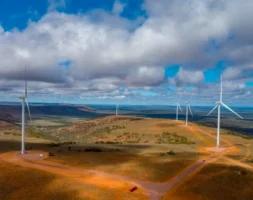With most of the world leaders now having departed Glasgow, the COP26 talks are now being carried forward by diplomats and negotiators, who have now begun to focus on the detailed negotiations of formal decision texts.
But ‘Day Three’ of the talks still managed to deliver some the announcement of major new commitments on climate finance and the release of a new analysis showing that new emissions reduction pledges might be enough to keep global warming within safer limits.
COP26 President confident of success
Alok Sharma, the British MP who serves as the UK appointed president of COP26, said on Wednesday that he remains confident that the conference is on track to deliver a successful outcome.
As hosts of the conference, the British government has set expectations high for the conference, hoping to see the event become the most significant round of international climate talks since those that delivered the Paris Agreement in 2015.
“We’re off to a good start at COP26; leaders came armed with the ambition that they should rightly be showing and the commitments we have so far seen are welcomed,” Sharma told a press conference.
“It is clear that there is no turning back. The world is firmly united in delivering a net zero resilient future. Around 90 per cent of the world economy is now covered by a net zero target. This compares to less than 30 per cent when the UK took on COP26.”
“Paris promised, and therefore Glasgow now must deliver.”
Sharma, however, continues to face criticism from civil society delegates, who have complained that tight restrictions to the COP26 venues have effectively barred observers from the negotiations.
#COP26 is turning into most exclusive COP over the past decade.
Observers are barred for now from any access to entire negotiating area despite so many reassurances from @COP26 and @UNFCCC Sec.
Even first days of Copenhagen compare better.
Here comes a short thread with context pic.twitter.com/9IhZIiWz0X— Sébastien Duyck 🌍⚖️ (@duycks) November 2, 2021
New pledges keep 2 degree goal in reach
One key measure of success for the talks will be whether countries can bridge the ‘ambition’ gap between national targets and the ambition needed to limit global warming to within safer levels.
New analysis published by Climate Resource suggests that new emissions reduction targets announced by countries during COP26 if delivered, could limit global warming to within 2 degrees.
Modelling produced by Climate Resource shows there is now a better than even chance of limiting global warming to just 1.9 degrees, based on the emissions targets announced to date.
“For the first time in history, the aggregate effect of the combined pledges by 194 countries might bring the world to below 2°C warming with more than a 50% chance,” Climate Resource’s report says.

“If all NDC and long-term pledges are fulfilled and adequately supported, the best-estimate peak warming this century is 1.9 C. This is still a far stretch from halting warming around 1.5K, but substantially improved over projections from just a few weeks ago.”
Key to this outcome was the formal pledges made by China and India to reach net zero emissions by 2060 and 2070, respectively. The group said further pledges would be required to ensure the warming could be kept below the 1.5-degree threshold.
However, the group noted that the success of these targets, as well as those made by other countries, lies in the implementation of necessary policies to ensure they are reached.
Show me the Money
Wednesday in Glasgow was all about finance, with a new investor initiative pledging to make at least US$130 trillion (A$175 trillion) available for investment in accelerating the transition to a net zero emission global economy.
The new group, the Glasgow Financial Alliance for Net Zero, was launched by UN Special Envoy for Climate Ambition Michael Bloomberg and former Bank of England governor Mark Carney, who have secured the commitments from asset managers, banking groups and pension fund managers.
“The architecture of the global financial system has been transformed to deliver net zero. We now have the essential plumbing in place to move climate change from the fringes to the forefront of finance so that every financial decision takes climate change into account,” Carney said.
“Only this mainstream focus can finance the estimated US$100 trillion of investment needed over the next three decades for a clean energy future.”
The initiative has drawn commitments from 450 investment groups across 45 countries, including Australia’s Macquarie Bank.
Make no mistake: the 💰 is now there if the 🌎 truly wants to arrest the #climatecrisis
Today, through the Glasgow Financial Alliance for Net Zero #GFANZ, over $130 trillion of capital from 450+ firms across 45 countries is committed to transforming the economy #COP26
— Mark Carney (@MarkJCarney) November 3, 2021
Greta pledges net zero swear words
Youth activist Greta Thunberg has been active in Glasgow, leading campaigners and activists demanding leadership from world leaders and delegates participating in the talks. Thunberg has drawn some attention for the use of some rather colourful language while addressing activists outside of the COP26 venue.
Earlier in the week, speaking to campaigners and media during the opening of the COP26 talks, Thunberg said that world leaders were not showing necessary leadership.
“This is what leadership looks like. We say no more blah blah blah, no more exploitation of people and nature and the planet. No more whatever the f**k they’re doing inside there,” Thunberg said.
Thunberg later sang “you can shove your climate crisis up your a**e”, to the tune of “she’ll be coming ’round the mountain” to a group of activists outside of COP26.
On Wednesday, Thunberg pledged to go “net zero” on the swearing, committing to “saying something nice” whenever she says something inappropriate.
I am pleased to announce that I’ve decided to go net-zero on swear words and bad language. In the event that I should say something inappropriate I pledge to compensate that by saying something nice. #COP26
— Greta Thunberg (@GretaThunberg) November 3, 2021
Has Australia abandoned its push for Kyoto Carryover?
Australia was a major antagonist at the previous round of UN climate talks, held in Madrid, when it demanded the ability to “carry over” its surplus emissions credits from the Kyoto Protocol into the Paris Agreement. The Morrison government argued that because it had overachieved on its 2020 target, it should be able to claim this as a credit against its 2030 target.
Unsurprisingly, this was met with strong opposition from countries that saw this move as going against the ‘spirit of the Paris Agreement’, and the issue remained unresolved.
An early draft text emerging from the Glasgow talks suggest that Australia’s push to keep the surplus credits may have been abandoned – with no mention of such an allowance.
Still being considered is the transfer of leftover units from the Clean Development Mechanism. The mechanism allowed developed countries to effectively offset emissions under the Kyoto Protocol by undertaking emissions reduction projects in developing countries.
Updated emissions projections published by the federal government suggest that Australia is on track to surpass its formal 2030 target to cut emissions by between 26 and 28 per cent, without the need for the surplus Kyoto Credits.
Negotiations on the future of the leftover Kyoto Protocol credits are expected to continue into next week.









